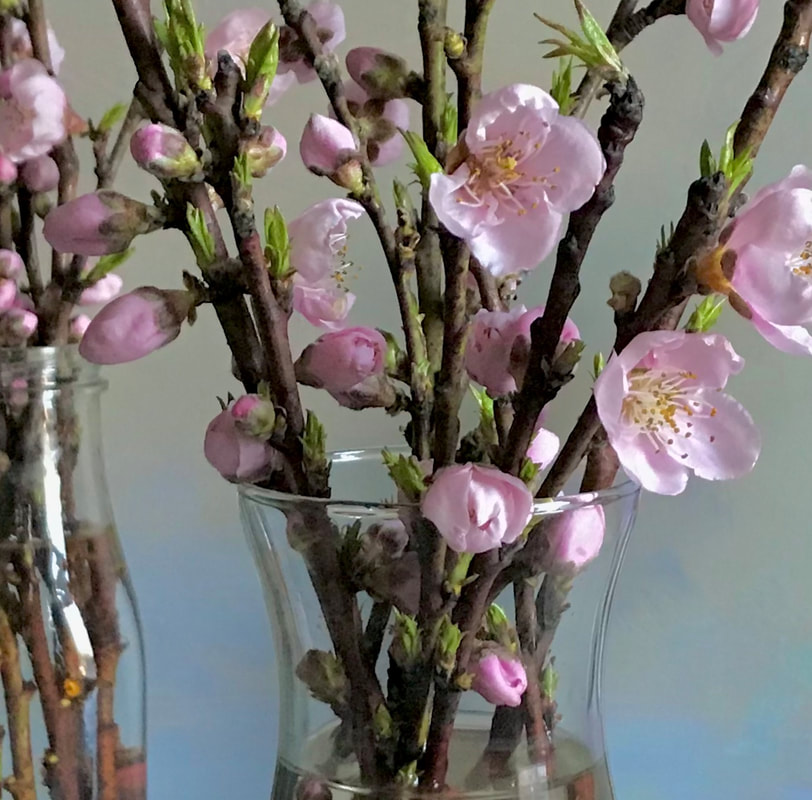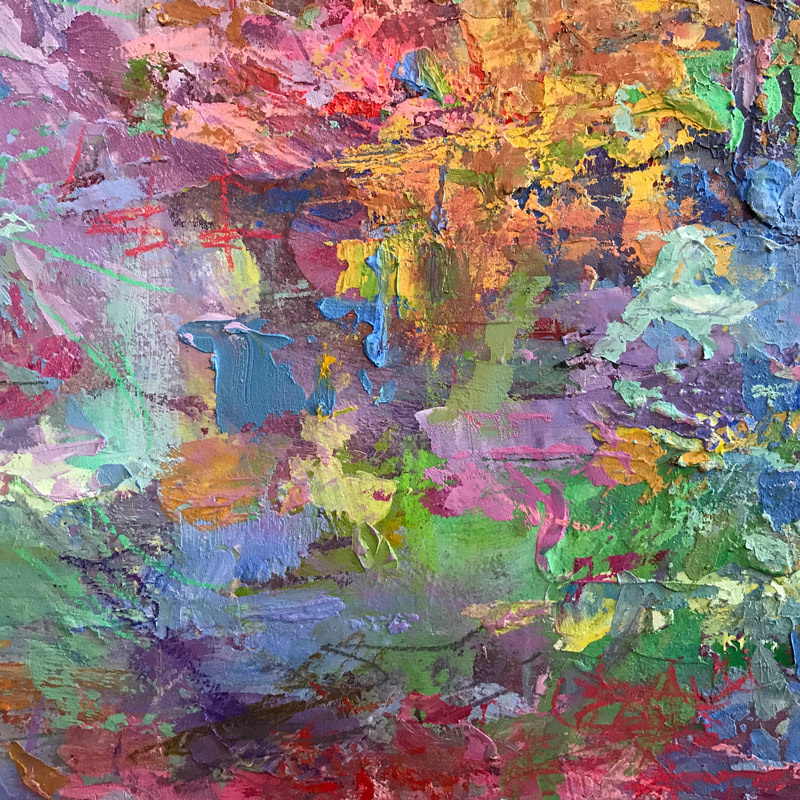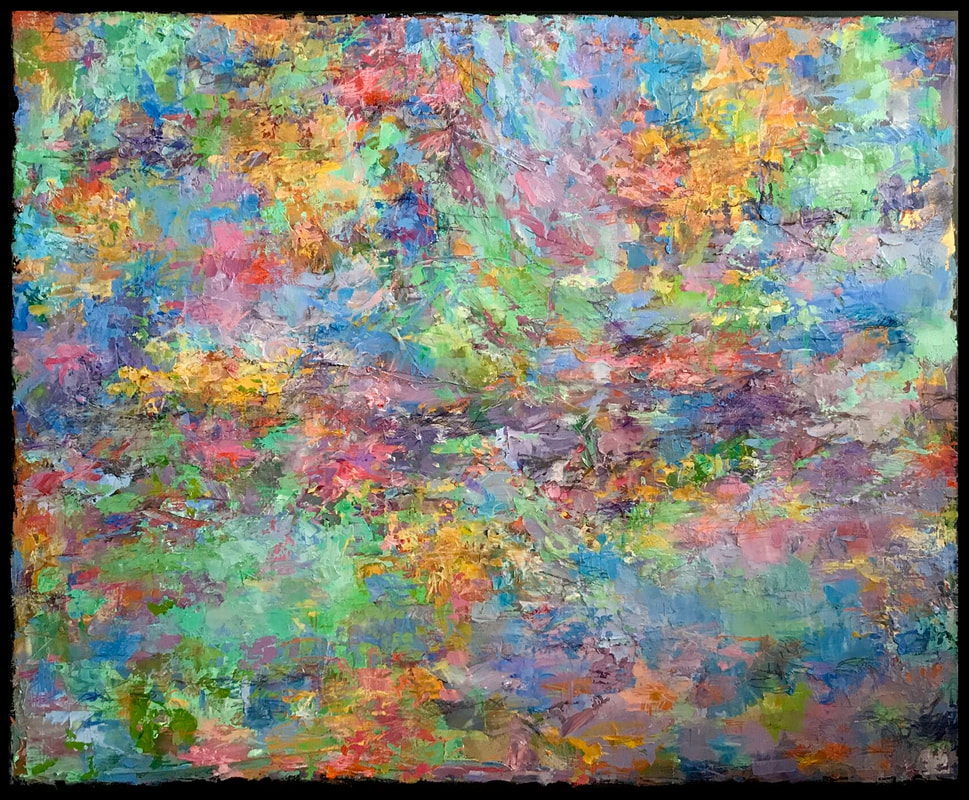A few days ago I noticed that buds were beginning to swell on the three dwarf fruit trees growing in my yard. The warm winter had apparently spurred some pre-spring waking up. Myself included, as I suddenly realized I needed to attend to pruning these trees, pronto! In the old school manuals that I’ve reviewed online, the suggested trimming amount to trim a peach trees is that “there should be enough space between the branches to swing a cat!”
0 Comments
“Weaving Memories of Peru,” 36” x 44” Mixed media/panel
[Left] 6” square detail from upper right quadrant; [Right] Full view of painting I’m posting this detail and the full view of a recent painting to highlight some things I feel are often missed regarding art posted on social media. Most of my artwork is abstract, so colors, tones, textures, and scale and the feelings they evoke are more important in my paintings than the illusion of depicting an object. (I intentionally took both photos in average daylight without fussing to get pristine, high resolution images.) I like to use varied textures and surfaces to create a vibrational effect, noticeable when before the actual work. For instance, in my paintings I often try to allude to the scintillating effects of light. Clearly the layers, textures, and subtle colors are more conspicuous in the detail on the left. But these aspects are merged or tend be minimized in photos and screen images, especially in the views of larger works (perhaps due to the “overall focus” effect of a lens on a 4’ x 4’ painting, which must “average out” the focus). A photographic image is fixed, it doesn’t shift focus from near to far—zoom in and out— as our eyes instinctively do when we’re looking at and connecting to a painting (or anything else in front of us) for a moment or two. Digital cameras have higher resolution each year, and screen views of art are a very convenient tool to get an idea of paintings from anywhere on the globe. But even with fine high res. images we’re required to make that extra effort and zoom in, and/or must have a big enough screen to really take in those details, and this assumes we can retain a sense of the whole painting in our mind as we do. I find it especially challenging with instagram and all small screen imagery to “feel” textures and get a sense of scale when I view them. Yet these are two things crucial to my paintings and the feelings they may awaken. Somehow we’re to just “imagine” these qualities as we look at a 4” x 3” cell phone screen. This is an unspoken expectation looking at art on an iPad or laptop too. In each case it requires a sort of leap in our mind’s eye. We’re so used to seeing objects “abstracted” into small scale digital images that we often ignore the inherent trade offs. There’s much skill required in discerning what feelings that object in a small image (especially those that aren’t illustrational or narrative) will convey if we were in front of the actual object. Colors are variable, fine details may be lost; the way a larger work will encompass our field of vision gets distorted on a small screen; the presence of the object scarcely gets conveyed in a photo. Yet we assume we can simply imagine (or ignore?) all these sensations and more, and often we make our judgments based solely on this very limited information. Even though I feel our minds can learn to “envision” this shift from a photo (with the object’s size listed) to sensing what a direct encounter will be like, even this is not an automatic transfer—we are distracted by a host of other things within and beyond the screen that may affect and color our response. Nor is being able to do so a “given” ability. I’ve learned that unless one has done this routinely (maybe some folks have a natural ability in this, others may learn it via their professions—IE architects, structural engineers, 3D designers), it’s not a skill innate to most people. In a similar way, I suspect a musician listening to digitally recorded music finds the sensations available and the subtleties of the experience very different from live performances. We make casual decisions via on-screen visuals for familiar things: shoes, clothing, tools, dinnerware, furniture—but as we all know, those judgments also have trade-offs. But the art experience feels more distorted—maybe I’m just more sensitive as a maker, or maybe because the scale of paintings is so entirely variable, until we’re directly before an actual work, we can’t begin to truly “know” the experience. So,despite the great convenience, any assessment of art that we make in this way is very much inhibited, restricted, and potentially distorted. I admit, digital imagery and screens are the tool of our times, and I use them to get a sense of more art than I ever could years ago. But I also try to keep in mind I’m only glimpsing a particular type of approximation of a work, which may reveal certain aspects, but also leaves many out. It’s an ongoing challenge to keep aware of the vast difference between a screen shot and the genuine experience we may have in person. Like reading comments in a FB post or text message that are always devoid of tone of voice, facial expressions, or body language versus having a REAL conversation with your neighbor on the sidewalk and sensing their emotions, feeling their presence, screen info just ain’t the same as the real thing and we ought not forget it ain’t. Engaging in direct encounters with people or works of art, even ones we may not love or want to see everyday, is always a richer experience, and worth the effort. It keep us more connected, we grow more, and it’s more fun! |
|



 RSS Feed
RSS Feed